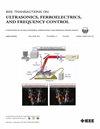Noninvasive Fluid-Level Sensing in Pipelines Using Ultrasonic Techniques
IF 3.7
2区 工程技术
Q1 ACOUSTICS
IEEE transactions on ultrasonics, ferroelectrics, and frequency control
Pub Date : 2025-01-03
DOI:10.1109/TUFFC.2024.3525407
引用次数: 0
Abstract
Accurate fluid-level assessment in sealed pipelines is crucial in wastewater treatment and petrochemical plants, among others. The traditional pulse-echo time-of-flight measurements using ultrasound sensors to measure the fluid level are challenging for low fill levels due to signal contamination with multiple echoes and the resonances in the pipe wall. Though signal-processing strategies such as baseline subtraction and narrowband filtering away from the pipe resonance frequencies improve pulse-echo measurements, low-fill-level detection remains challenging. In this work, we identify these limitations of the pulse-echo technique and propose a resonance-based ultrasonic technique that is accurate and sensitive even at low fill levels. This technique relies on the attenuation of pipe resonances in the presence of fluid, which is validated numerically using time-domain finite-element simulations and experimentally performing resonance measurements on a fluid-filled pipe using an array of transducers. However, the pulse-echo and resonance techniques demand precise calibration with the pipe system before use. To mitigate the need for calibration, we propose a wedge-based phased-array imaging technique based on the total focusing method (TFM) for fluid-level sensing. We discuss the challenges in wedge selection and array positioning and numerically validate the efficiency of TFM to provide better visualization of low fluid levels using a strategy to filter the image artifacts selectively. The presented ultrasonic techniques have significant industrial importance for applications requiring noninvasive fluid-level measurements.超声技术在管道中的无创液位传感
在污水处理和石化工厂等中,密封管道中准确的液位评估至关重要。传统的脉冲回波飞行时间测量方法使用超声波传感器来测量液位,由于信号受到多重回波的污染和管壁的共振,在低填充水平下具有挑战性。尽管基线减法和管道共振频率窄带滤波等信号处理策略改善了脉冲回波测量,但低填充电平检测仍然具有挑战性。在这项工作中,我们确定了脉冲回波技术的这些局限性,并提出了一种基于共振的超声波技术,即使在低填充水平下也能准确和敏感。该技术依赖于流体存在时管道共振的衰减,通过时域有限元模拟进行数值验证,并使用一系列换能器在充满流体的管道上进行共振测量。然而,脉冲回波和共振技术在使用前需要与管道系统进行精确校准。为了减少校准的需要,我们提出了一种基于全聚焦法(TFM)的楔形相控阵成像技术用于液位传感。我们讨论了楔形选择和阵列定位方面的挑战,并通过数值验证了TFM的效率,通过有选择地过滤图像伪影的策略,可以更好地显示低液位。所提出的超声波技术对于需要无创液位测量的应用具有重要的工业意义。
本文章由计算机程序翻译,如有差异,请以英文原文为准。
求助全文
约1分钟内获得全文
求助全文
来源期刊
CiteScore
7.70
自引率
16.70%
发文量
583
审稿时长
4.5 months
期刊介绍:
IEEE Transactions on Ultrasonics, Ferroelectrics and Frequency Control includes the theory, technology, materials, and applications relating to: (1) the generation, transmission, and detection of ultrasonic waves and related phenomena; (2) medical ultrasound, including hyperthermia, bioeffects, tissue characterization and imaging; (3) ferroelectric, piezoelectric, and piezomagnetic materials, including crystals, polycrystalline solids, films, polymers, and composites; (4) frequency control, timing and time distribution, including crystal oscillators and other means of classical frequency control, and atomic, molecular and laser frequency control standards. Areas of interest range from fundamental studies to the design and/or applications of devices and systems.

 求助内容:
求助内容: 应助结果提醒方式:
应助结果提醒方式:


